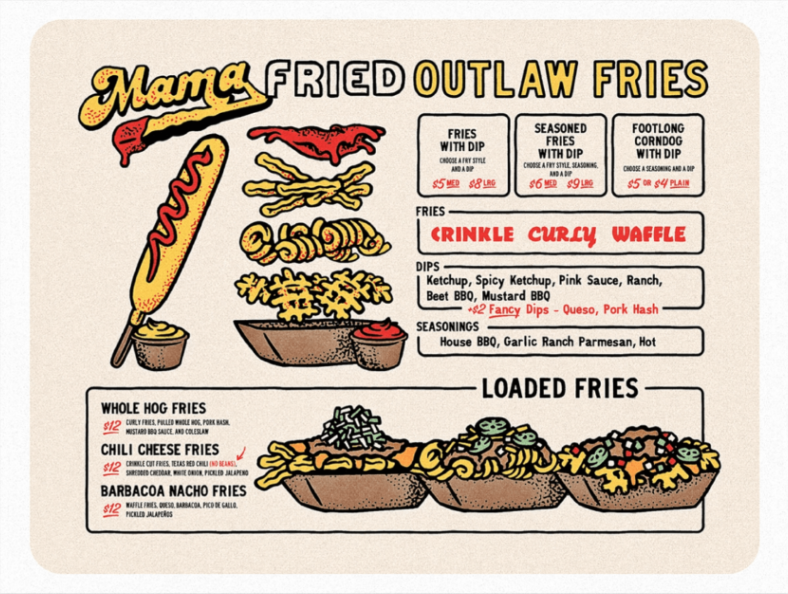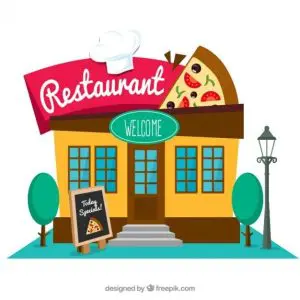Your menu is a silent salesperson, whispering temptations into your customers’ ears. But here’s the twist: most restaurant owners are accidentally sabotaging their profits with poorly designed menus.
Picture this: A hungry diner sits down, menu in hand. Their eyes dart across the page, drawn by invisible forces. In mere seconds, decisions are made that could make or break your bottom line.
What if I told you that the placement of a single dish could boost its sales by 30%? Or that removing a simple symbol could increase overall spending? These aren’t hypotheticals – they’re the results of decades of research into menu psychology.
But beware: common “wisdom” about restaurant menu design is often dead wrong. That fancy font you love? It might be costing you thousands. Those mouth-watering photos? They could be driving customers away from your most profitable items.
The truth is, that effective restaurant menu design is equal parts art and science. It’s a delicate dance of psychology, visual hierarchy, and strategic pricing. Get it right, and you’ll watch your sales soar. Get it wrong, and you’re leaving money on the table with every order.
In this deep dive, we’ll uncover the secrets top restaurants use to turn their menus into profit-generating machines. You’ll learn how to guide your customers’ eyes, influence their decisions, and boost your bottom line – all without saying a word.
Are you ready to transform your menu from a simple list of dishes into your most powerful sales tool?

Lower your delivery costs by 23%
How we reduce costs:
- No delivery vehicle expenses
- Optimized local routes
- Pay-per-delivery model
- Average 23% delivery cost reduction
1. Menu Templates: Effective Menu Layout Strategies
Craft menus into sections for easy reading.
Mix aesthetics with practicality in design.
The step-by-step process ensures clarity and improves sales.
1.1 Organizing the Menu Sections
Logical Categories
Start by splitting your menu into clear sections. Simple categories are starters, mains, and desserts. Include subcategories if needed like ‘seafood’ or ‘vegetarian’. Logical sections help customers find what they want fast. This structure matches how people think about meals, making their choices easier.
Consider using a two-column layout if the menu has many items. This layout guides the customer’s eyes smoothly. In each section, list items in an order that makes sense, like from light to heavy dishes.
Clear Headings and Flow
Use bold and descriptive headers. Headers define each section and help customers navigate the menu. Place these at the top of each section, using a larger font size. Also, ensure the text flows logically, guiding the eyes. Customers read menus from the top left corner, similar to how they read books, so start with popular or signature dishes there.
A well-structured menu reduces the time spent scanning. On average, customers spend around 109 seconds looking at menus. Use this time wisely by keeping the layout intuitive. For those looking to take their menu to the next level, you can explore various restaurant menu design templates. These templates not only enhance the aesthetic appeal but also incorporate strategic layout techniques to optimize customer engagement and sales.
1.2 Balancing Visual Appeal with Functionality
Aligning Food Photos and Other Visuals with Theme
Integrate visual elements that match your restaurant’s style. Choose fonts that echo your brand’s tone—casual or formal. The right fonts add character but remain legible. Stick to one or two fonts to maintain clarity. Colors are crucial; they should reflect the atmosphere. Warm colors can stimulate appetite, but too many bright colors distract.
Add high-quality images sparingly, such as for signature dishes or meals you want to promote. Pictures can draw attention better than words. But don’t overwhelm the page; each visual must serve a purpose and harmonize with the menu’s theme. Illustrations are another option to show personality if photos are unsuitable.

Maintaining White Space
Keep your design uncluttered by using white space. White space is just empty areas around text and images. This space allows the design to breathe and helps avoid visual overload. It also directs attention to specific parts of the menu, enhancing readability and focus.
Menus with too many elements can confuse customers. Keep space between items and sections. This separation aids in a smoother decision-making process.

1.3 Online and QR Code Restaurant Menu Design Strategies
Optimizing for the Digital Experience
When designing an online menu, leverage multimedia elements like high-quality food photos and videos showcasing meal preparation. These visuals can bring your dishes to life and whet the customer’s appetite. Incorporate interactivity through features like hover-over dish descriptions or the ability to toggle between menu sections. This enhances engagement and makes it easier for customers to explore your offerings.
Digital Menus Popularity
As of 2024, the USA leads in QR code menu usage with 26%.
Ensure your online menu is mobile-responsive, as many diners will be accessing it on their smartphones. The layout should seamlessly adapt to different screen sizes while maintaining clear organization and readability.
Leveraging QR Code Menus In-Restaurant
In addition to your online menu, consider implementing QR code menus within your physical restaurant setting. This allows customers to access your full menu digitally using their own mobile devices. Strategically place QR code displays at key touchpoints, such as table tents or signage near the entrance. This makes it easy for customers to scan and access your full menu selection.
QR Code Usage
Approximately 60% of patrons report using a restaurant QR code menu or promotional offers.
Ensure your online and QR code menus seamlessly integrate with your overall restaurant branding. Utilize consistent fonts, colors, and design elements to create a cohesive visual identity. This reinforces your brand image and leaves a lasting impression on customers.
2. Restaurant Menu Design Psychology Techniques
Highlight the impact of visual elements on customer choices.
Use strategic focal points to boost sales with high-profit items.
Tap into psychology to make menus a sales powerhouse.
2.1 Leveraging Visual Psychology
Visual factors can heavily influence customer purchases. The presentation of the menu can draw attention to certain items. Highlighting high-margin dishes by using boxes or different font styles is one of the most effective strategies identified in restaurant menu design. This tactic isn’t just about aesthetics; it’s about drawing the eye to where you want the customer to look. When a visually distinctive design element surrounds an item, it stands out more among other offerings. This attention-catching strategy can lead to increased interest and ultimately, higher sales for those highlighted items.
The Power of Menu Psychology
A well-designed menu can increase profits by up to $1,000 monthly, per million in annual revenue.
Strategically positioning these highlighted items is as important as the highlighting itself. The concept of the “Golden Triangle” suggests that the most attention-grabbing spots on a menu are the middle, top right, and top left sections. By placing your most profitable or popular dishes in these locations, you’re capitalizing on natural reading patterns. Studies indicate that customers tend to focus on these areas first, which means those prime spots are crucial real estate for driving up sales. Understanding these viewing patterns can significantly enhance the effectiveness of visual psychology in menu design.
Understanding these tactics requires a deeper dive into behavioral studies and how visual cues influence choices. Books like “Priceless: The Myth of Fair Value” by William Poundstone provide insights into these psychological principles. For professionals eager to integrate such strategies, it might be worth looking into industry white papers or training sessions on effective menu design. “Ultimately, it’s about minimizing the focus on price,” as Poundstone notes, emphasizing the importance of subtlety in visual cues to drive sales.
2.2 Creating a Focus Area
Within the menu landscape, focal points serve as attention magnets. Employing images or icons sparingly can guide a customer’s gaze without overwhelming them. The aim is to make sure that these elements draw the eye to what’s really important—your signature or high-profit items. Icons aligned with the restaurant’s theme can additionally reinforce branding, making the customer’s experience more memorable and cohesive.
Brand Consistency
Consistent brand presentation across all platforms can increase revenue by up to 23%.
Creating a focus area isn’t about cluttering the menu with graphics. It’s about strategic placement to ensure key dishes are in the line of sight. The short path of vision—typically right where a diner naturally looks first—should feature these high-value dishes. Effectively designed focus areas ensure customers are gently guided towards choices that are both satisfying for them and profitable for the establishment. Using eye-tracking technology can reveal these “sweet spots” by analyzing natural reading paths, and optimizing item placement even more effectively. Additionally, incorporating visually attractive templates can streamline your design process and make your menu more appealing. For helpful resources, check out these customizable restaurant menu design templates that can help elevate your business.
Debate rages in design circles about the correct balance of graphics to text. Some argue that too much reliance on visual cues risks reducing the sophistication of a menu while others see it as an invaluable tool for guiding customer choices. For those interested in diving further, check out “Why We Buy: The Science of Shopping” by Paco Underhill. This book explores how visual cues in various settings, menus included, affect decision-making and can help refine these strategies even more.
Avoiding Decision Fatigue
Limiting menu options can improve decision-making. Decision fatigue is a real psychological condition where too many choices exhaust the customer. The rule of seven advises limiting options in each category to prevent overwhelming the diner. Besides easing decision-making, it strategically channels customers toward more profitable selections. Simplifying choices can also help restaurants maintain a more consistent kitchen output and better control over inventory.
Menu Item Reduction
60% of full-service restaurants reported having fewer menu offerings prior to the pandemic, indicating a trend towards simplification.
Streamlining isn’t just about choice quantities; it also involves smart categorization. Creating clear, logical sections enables faster scanning and helps guide diners through the menu experience. Alignments with restaurant themes and consistent use of language further ensure that the customer doesn’t feel bombarded with information, but rather subtly directed to what the restaurant wishes to promote.
For a deeper understanding, exploring Simon Sinek’s works could be invaluable. His insights into decision-making psychology could help franchise owners manage those menu choices, thereby aligning customer desires with restaurant goals more effectively.
Throughout these techniques, maintaining a focus on how visual strategies interact with customer choices is crucial. By doing this, menus not only act as a list of offerings but also as a powerful sales tool.
3. Enhancing Menu Readability
Make sure your menu’s font is readable for everyone.
Use short and clear descriptions for each dish.
Boost sales by improving how your menu looks.
3.1 Choosing Readable Fonts and Sizes
Choosing the right fonts and sizes is crucial for a good menu. First, readability is key. Pick fonts that are clean and simple. Avoid overly decorative fonts; they can be hard on the eyes, especially in dim lighting. Sans-serif fonts often work well here.
Opt for Larger Font Sizes
Font size can’t be ignored. For the main dish names, a larger font size helps them stand out. Subheadings should be slightly smaller but still noticeable. Smaller fonts can be used for descriptions, but they have to be big enough to read without squinting. It’s about balancing style and function. Make sure your menu reads well from a distance.
Test in Low Light
Restaurants often have mood lighting. Test your font choices in these settings. What looks good on a computer screen might look terrible in low light. Remember, about 1 in 4 people have some difficulty seeing small print, especially in poor lighting. Making your menu readable increases accessibility and ensures every guest can easily see the options available.
3.2 Streamlining Menu Descriptions
Crafting menu descriptions that sell is an art. Each word should count. A good description doesn’t just say what’s in the dish. It needs to make customers want to eat it. Avoid being too wordy. Too many words can confuse or bore customers.
Be Concise but Enticing
Keep it simple. Describe dishes in a few words. Focus on unique ingredients or cooking methods. Use words that evoke taste and aroma. For example, instead of “cooked chicken,” try “roasted chicken with a hint of garlic.”
Action-Oriented Descriptions
Good menu descriptions include action words. They make the dish come alive. Words like “sizzling,” “drizzled,” and “glazed” can help create vivid pictures. They make the food sound inviting and dynamic. This can encourage diners to try a dish they might otherwise skip.
A good menu can significantly impact conversion rates. However, improving readability won’t just boost immediate sales. It also builds trust. When customers don’t have to struggle to understand what’s on a menu, they’re more likely to enjoy their meal experience. This trust can encourage return visits and increased profitability over time.
Customer Decision-Making
Customers typically spend less than two minutes reviewing a menu, making it crucial for the menu to convey essential information quickly and clearly.
Now that the menu is set for clarity and attractiveness, the next vital piece deals with pricing that does more than just reflect the cost of a meal.
4. Profitable Pricing Tactics
Boost restaurant sales using strategic pricing methods.
Highlight signature dishes to create a value perception.
Increase profits with pricing tiers.
4.1 Implementing Strategic Pricing
Strategic pricing can significantly affect your profits. By avoiding currency symbols, you can subtly shift focus away from the price itself. This approach can reduce price resistance and smooth the decision-making process for customers. The idea is to emphasize the food’s value rather than its cost, aligning with insights from behavioral economics studies.
Creating Price Tiers
Price tiers guide customer choices toward more profitable options. Imagine a menu with distinct sections for budget, mid-range, and premium items. This kind of segmentation encourages customers to gravitate towards mid-tier options, perceived as offering the best value. Harvard Business Review notes that price tiering can psychologically position certain items as ‘bang for the buck,’ often leading to higher expenditure per customer.
Dynamic pricing leverages algorithms that adjust prices based on demand and other factors. Research indicates that implementing price management can increase margins by 2 to 7% within a year. Dynamic pricing’s flexibility helps capitalize on peak times with higher prices and slower periods with discounts.
Role of AI and Machine Learning
AI and machine learning are becoming indispensable in pricing strategies. They can predict optimal pricing by using algorithms that factor in past data and current market conditions. Segmented pricing taps into this tech by understanding distinct customer behavior patterns. Brands using these methods can align their pricing strategies to offer personalized experiences without manually adjusting each price point.
4.2 Highlighting Signature Dishes
Signature dishes can be powerful anchors. They set benchmark prices around which other items are considered. Pricing a flagship item at a premium creates an expectation that elevates the perceived value of the entire menu. Successful implementation of this technique can be seen in fine dining, where a single celebrated dish often defines the dining experience and establishes a price baseline.
Applying Value Perception
Price perception heavily influences sales. By positioning certain items in the mid-range, diners perceive they are getting good value. Biblical principles from behavioral economics suggest that customers are likely to choose an item that balances quality and price, avoiding extremes. Books like “Priceless: The Myth of Fair Value (and How to Take Advantage of It)” by William Poundstone explore these psychological aspects of pricing.
Warren Buffett famously stated that customer purchases hinge on perceived value. This underscores why pricing is not just about numbers but the story they tell about an item’s worth.
Advanced Algorithms and Pricing Models
Using advanced algorithms, like the Value Attributes methodology, lets you find the most effective pricing strategy. These algorithms determine how to maximize margins without losing sales. Pricing models that are data-driven offer nuanced insights, allowing continuous refinement of strategy for improved financial performance. Companies that utilize these models report substantial competitive advantages.
Further study into dynamic pricing and the application of artificial intelligence in pricing strategies might include works like “Smart Pricing: How Google, Priceline, and Leading Businesses Use Pricing Innovation for Profitability” by Jagmohan Raju and Z. John Zhang. It deepens the understanding of tailoring prices to enhance perceived value and customer engagement.
Advanced Tips for Optimizing Menu Design
Menu audits identify item performance and sales drivers.
Strategic item placement and size maximize customer attention.
Overpopulation of items can lead to decreased sales efficiency.
Additional Techniques for Maximizing Sales
Regular Menu Audits
Conducting regular menu audits is key to understanding which items perform best. This involves analyzing sales data to pinpoint items that yield high returns and those that do not. A process referred to as menu engineering categorizes items into groups like “Stars” (high profitability and popularity) and “Dogs” (low profitability and popularity). Menu engineering helps tailor menus based on what’s lucrative.
Audits should happen often enough to catch changing trends and customer preferences. Aim to update or remove items that don’t move to save costs and enhance efficiency. Books like “Menu Engineering: A Practical Guide” by Michael L. Kasavana provide deeper insights into effectively evaluating menu performance and making informed decisions.
Experiment with Menu Rotation
Menu rotation involves changing menu offerings at set intervals to maintain customer interest and freshness of options. Seasonal menu rotations can align with ingredient availability, enhancing both sustainability and cost reduction. Regular rotation keeps the menu exciting and encourages repeat visits by offering new or improved selections that align with evolving customer tastes.
Sustainability Boosts Loyalty
Brands focusing on sustainability saw a 56% growth advantage in certain categories over five years, outperforming non-sustainable counterparts.
Consider investigating the principles of “The Flavor Bible” by Karen Page to fetch inspiration for seasonal pairings. This can boost creativity while ensuring new items resonate with the audience.
Common Pitfalls and How to Avoid Them
Overcrowding the Menu
Overcrowding occurs when too many options confuse customers, detracting from overall satisfaction and reducing sales. It can slow down decision-making and reduce table turnover, lowering potential revenue. Research shows that restaurants with smaller menus tend to have higher Yelp ratings. This indicates a more focused selection leads to greater satisfaction and efficiency.
To avoid overcrowding, curate a menu emphasizing quality over quantity. This streamlines kitchen operations and ensures items showcased are the ones staff can execute exceptionally. Watch “Setting the Table” by Danny Meyer for insights on balancing a menu that aligns with service and quality.
Inconsistent Pricing Strategies
Avoid frequent and unexplained price changes as they disrupt customer trust. Consistency is crucial. Frequent changes can confuse customers and could lead to perceived unreliability. Maintaining stable prices allows guests to predict spending, enhancing trust and repeat visits.
Price changes should stem from significant product or cost adjustments, accompanied by transparent communication strategies. For a deeper understanding, “Priceless: The Myth of Fair Value” by William Poundstone explores the psychological impact of pricing on consumer behavior, providing valuable insights for consistent pricing management.
Strategic Use of Visual Elements
Eye-Catching Details
Implementing strategic visuals, like color accents or vibrant images, can significantly impact how customers perceive and choose items. For instance, callout boxes and eye magnets can draw focus to high-margin dishes. A fact worth noting: placing high-margin items in prominent spots can boost sales, with photos increasing item sales up to threefold.
Effective visual strategies should enhance the menu’s thematic coherence. Pairing visuals with a compelling narrative, as discussed in Edward Tufte’s “The Visual Display of Quantitative Information,” can optimize customer engagement without overwhelming them.
Incorporating Seasonal Changes
Seasonal Menu Adaptation
Adapting the menu to seasonal offerings keeps it fresh. Seasonal items not only reduce costs but also highlight freshness. This tactic can improve profitability by taking advantage of seasonal pricing and availability. Restaurants with menus that evolve with seasons often see higher guest satisfaction.
Exploring local seasonal trends and integrating them into your offerings can give your menu a competitive edge. Use texts like “The New American Chef” by Karen Page to explore how to incorporate global culinary techniques into seasonal offerings.
Troubleshooting Common Issues
Identify and resolve menu layout complaints efficiently.
Adapt seamlessly to ingredient availability for smooth operations.
Addressing Negative Feedback
Negative feedback isn’t just about pointing fingers—it’s a roadmap for improvement. One effective way to manage feedback is by actively keeping an eye on customer reviews. This might include direct comments on dining apps or feedback forms at your location. By analyzing these inputs, you can spot recurring issues. Maybe guests often mention difficulty finding certain sections on your menu, or they feel overwhelmed by too many choices.
Identifying Patterns in Feedback
Gather All Feedback: Set up a system to collect feedback regularly from all available channels. This could be through surveys, comments on platforms like Yelp, or direct feedback from servers.
Analyze for Trends: Once you have a pile of comments, look for trends. Are people consistently mentioning that appetizers are hard to find, or is there a frequent mention of confusing pricing structures?
Prioritize Issues: Decide which issues are the most pressing based on frequency and impact. Focus on changes that will uplift the customer experience the most.
Implementing Changes
Collaborate with Your Team: Bring in managers and design experts to brainstorm solutions that address major complaints. Keeping your team in the loop ensures that changes align with operational capabilities.
Test Adjustments: Try out small changes before overhauling the entire menu. For instance, if certain items need highlighting based on feedback, consider tweaking the design around them first. Monitor if these adjustments positively affect the guest experience.
Handling Seasonal Variability
Restaurants face unique challenges with seasonal changes impacting ingredient availability. Adapting the menu to reflect what’s fresh and accessible can boost the dining experience. It’s also a great way to ensure cost-effectiveness and maintain sustainability.
Sustainability as a Purchase Driver
77% of consumers consider sustainability an important factor in their purchase decisions, with many actively seeking out eco-friendly options.
Menu Adjustments Based on Availability
Plan Ahead: Design your menu with flexibility in mind. Knowing what ingredients are available during certain times of the year helps in planning and minimizes last-minute scrambles.
Create Seasonal Specials: Develop a list of potential seasonal dishes that can rotate through your menu. This keeps offerings fresh and gives diners something to look forward to each season.
Communication is Key
Inform Customers: Use your menu to inform diners of the temporary nature of seasonal items. This can be a simple asterisk by the dish name or a short note indicating it’s seasonal.
Leverage Technology: Update your website and social media channels to reflect any menu changes. This level of communication not only manages expectations but also creates a buzz around new seasonal offerings.
Incorporate insights like the impact of using sustainable ingredients, which not only appeals to eco-conscious diners but can also potentially increase sales.
Sales Growth of Sustainable Products
A survey revealed that consumers are willing to pay an average of 9.7% more for sustainably produced goods, even amidst rising costs of living.
Further Resources and Reading
Behavioral principles offer insight into why people choose certain dishes.
Success stories show real-world applications and results.
Menu design affects customer experience and choices profoundly.
Exploring Advanced Menu Design Theories
An in-depth understanding of menu design can significantly boost a restaurant’s success. Literature on behavioral menu design explores the psychology behind diners’ choices. For instance, smaller menus often receive higher Yelp ratings. Numbers show a clear link between simplicity and positive reviews. This suggests that a more focused offering can make diners feel less overwhelmed and more satisfied. Research also suggests placing high-margin items in key menu spots. People tend to look at the top right-hand corner of menus first. This spot is ideal for drawing attention to lucrative dishes.
Another crucial aspect is the use of visual elements. Photos next to menu items can significantly impact sales. Items with photos saw their sales triple compared to those without. This provides a compelling reason to integrate visuals into menu design. However, it is important to consider the restaurant’s overall theme and aesthetic when adding such elements to ensure consistency.
Why Menu Design Matters in Restaurant Success
The design of a menu goes beyond aesthetics and directly influences customer satisfaction and decision-making. Effective menu design shapes dining experiences by guiding customers towards the intended selections. Data-driven insights are an invaluable resource for refining these designs. For example, more than a third of restaurant owners are planning to use data analysis to better understand customer preferences, according to the Square Future of Restaurants Report 2024.
The placement of dishes can also guide customers’ choices. Tools like TURF analysis help identify the essential items that need to stay on a menu while cutting down on clutter. A real-world application of TURF led a fast-casual restaurant to slim down its menu from 37 to 25 items. Even after this reduction, they still met the preferences of 91% of their customers. This balance maintains customer loyalty while ensuring operational efficiency. Such strategies do not just streamline operations but also enhance the overall dining experience.
Conclusion
Your restaurant menu design is more than a list—it’s a silent salesperson, tirelessly working to boost your bottom line. By applying these design principles, you’re not just changing how your menu looks; you’re reshaping how customers interact with your restaurant’s menu. Remember, a dazzling menu guides choices, enhances experiences, and ultimately drives sales.
As you implement these strategies, stay attuned to your customers’ responses. Their feedback is gold, especially if you operate at multiple locations where preferences might vary. Keep testing, tweaking, and refining your fresh menu to stay aligned with your restaurant brand and your patrons’ evolving tastes.
The power to transform your restaurant’s performance is now in your hands. Will you stick with the status quo, or will you dare to redesign your menu for maximum impact? The choice is yours, but the potential rewards are clear. Your next big sales boost could be just a menu redesign away. Are you ready to turn these tips into tangible results?


























